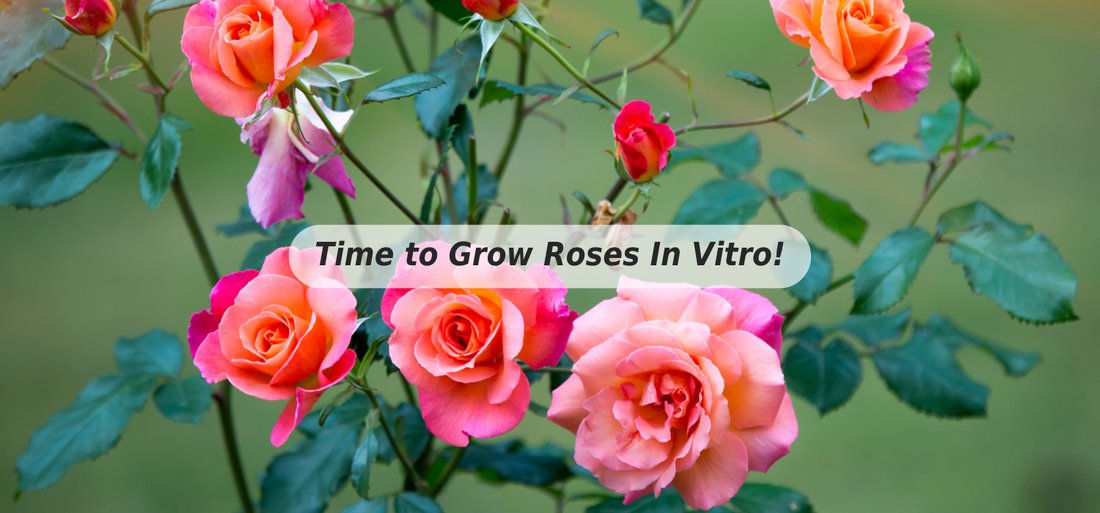
Rose Micropropagation: A Comprehensive Overview
As a content and community manager, I leverage my expertise in plant biotechnology, passion for tissue culture, and writing skills to create compelling articles, simplifying intricate scientific concepts, and address your inquiries. As a dedicated science communicator, I strive to spark curiosity and foster a love for science in my audience.


Introduction
Valentine’s Day just passed—did you gift a rose to your loved ones?
Roses have long been cherished for their beauty, fragrance, and deep symbolism, making them one of the most beloved ornamental plants worldwide. Whether as a token of love, an offering in religious ceremonies, or an essential decoration at events and celebrations, the demand for roses is ever-growing. From poojas and weddings to festivals and personal gardens, this iconic flower holds a special place in every culture.
But have you ever wondered how such an immense global demand for roses is met?
Traditionally, roses are propagated through stem cuttings, a simple and widely used method. While effective, it comes with significant challenges, including slow multiplication rates, susceptibility to diseases, and seasonal dependency.
As consumer demand continues to rise, traditional propagation isstruggling to keep up, highlighting the need for a more efficient and scalable solution.
This is where tissue culture technology steps in. In vitro propagation offers a revolutionary approach to growing roses, allowing for the rapid production of disease-free, genetically uniform plants. This modern technique is helping nurseries, commercial growers, and researchers scale up rose production while maintaining superior quality and resilience.
In this blog, we’ll explore how tissue culture is transforming rose propagation, ensuring a sustainable and reliable supply to meet the ever-increasing demand.

Rose Tissue Culture: Exploring Propagation Methods
Rose tissue culture, or micropropagation, offers several ways to multiply these beloved flowers. This blog post explores the various in vitro propagation methods, including meristem culture, callus culture, anther culture, protoplast culture, pollen culture, and suspension culture.
1. Meristem Culture: The Foundation of Micropropagation
Meristem culture, utilizing apical or axillary buds, is a cornerstone of rose micropropagation. These buds, containing actively dividing cells, can be induced to form multiple shoots under controlled conditions.
Numerous studies have demonstrated successful micropropagation of various rose species and cultivars using this technique. Factors like media composition (often MS medium), growth regulators (cytokinins like BA are crucial for shoot multiplication), temperature, and explant size all play a significant role in the success of meristem culture.
Research has shown that the position of the bud on the stem also influences its development, with mid-stem buds often exhibiting the fastest growth.

2. Callus Culture and Plant Regeneration: A Pathway to Variation
Callus culture involves growing undifferentiated plant tissue (callus) on a suitable medium. While not always the primary method for rose propagation, callus culture offers opportunities for plant regeneration and can be a valuable tool for research and breeding.
Different explants, from shoot primordia to anthers, can be used to initiate callus. The balance of auxins and cytokinins in the media is crucial for callus initiation and proliferation. Plant regeneration from callus can be achieved by manipulating the hormone balance to induce shoot and root formation.
This method has been used to regenerate adventitious shoot buds from various rose species and cultivars.
3. Anther Culture: Producing Haploid Plants
Anther culture, the in vitro culture of anthers (the pollen-producing part of the flower), offers a unique approach to rose breeding. This technique can produce haploid plants, which have half the number of chromosomes compared to the parent plant.
While callus induction from rose anthers has been reported, successful regeneration of whole plants from anther-derived callus is still an area of ongoing research.
4. Protoplast Culture: Exploring Cellular Potential
Protoplast culture involves isolating plant cells without their cell walls (protoplasts). This technique has the potential to overcome sexual incompatibility barriers and facilitate hybridization between rose and related genera.
While protoplast isolation and callus formation have been achieved in roses, regenerating complete plants from protoplast-derived calli remains a challenge.
5. Pollen Culture: Understanding Pollen Biology
Pollen culture focuses on the in vitro germination and growth of pollen. Research has explored the factors influencing pollen germination in roses, including pH and the presence of boric acid.
This technique is valuable for studying pollen viability and can be used in rose breeding programs.

6. Suspension Culture: Studying Cell Growth
Suspension culture involves growing plant cells in a liquid medium. This method is useful for studying cell growth, metabolism, and the production of secondary compounds.
While cell suspension cultures have been established for rose, their primary application is often research-oriented rather than for direct plant propagation. These various in vitro techniques offer a range of possibilities for rose propagation, research, and breeding.
From the widely used meristem culture to the more specialized techniques like anther and protoplast culture, each method contributes to our understanding of rose biology and helps meet the ongoing demand for this beautiful and commercially important flower.
Procedure to Grow Roses In Vitro
This guide outlines a rose tissue culture procedure based on a study published in HortScience (2022), focusing on the regeneration of three popular rose cultivars: Italian Ice®, Carefree Beauty™, and Ringo All-Star™.
This protocol emphasizes the importance of cultivar-specific optimization for successful regeneration.
Rose Tissue Culture Protocol (Simplified)
This protocol provides a general guideline for rose tissue culture. Remember that specific requirements might vary slightly depending on the rose cultivar.
1. Preparation:
-
Select healthy, actively growing rose plants.
-
Take shoot tip or axillary bud explants (about 1-2 cm long).
-
Wash explants thoroughly under running water for several hours.
-
Sterilize explants in a 20% bleach solution (with a drop of Tween 20) for 20 minutes.
-
Rinse explants three times in sterile distilled water (5 minutes each rinse).
2. Shoot Initiation and Multiplication:
-
Prepare MS (Murashige and Skoog) medium supplemented with:
-
30 g/L sucrose
-
0.1 g/L myo-inositol
-
0.1 g/L MES
-
6.5 g/L agar
-
5 µM BAP (6-benzylaminopurine)
-
0.5 µM NAA (α-naphthaleneacetic acid)
-
Adjust pH to 5.7. Autoclave the medium.
-
Place sterilized explants on the prepared medium in sterile containers.
-
Maintain cultures at 23°C under a 16/8 hour light/dark cycle.
-
Subculture (transfer to fresh medium) every 4-5 weeks to encourage shoot multiplication.
3. Rooting:
-
Prepare MS medium as above, but without BAP and NAA. Instead, add:
-
2.5 - 10 µM IAA (indole-3-acetic acid) - start with lower concentrations and adjust as needed
-
Transfer well-developed shoots (at least 2-3 cm long) to the rooting medium.
-
Maintain cultures under the same environmental conditions as before.
4. Acclimatization:
-
Once roots have developed (usually within a few weeks), carefully remove plantlets from the culture vessels.
-
Gently wash away any remaining agar from the roots.
-
Plant the rooted plantlets in a well-draining potting mix (e.g., peat and vermiculite).
-
Place the newly potted plants in a humid environment (e.g., a misting chamber or under a clear plastic cover) to gradually reduce humidity.
-
Gradually expose the plants to less humidity over several weeks.
-
Once established, transfer the plants to standard growing conditions.
Important Considerations:
-
Sterility: Maintain sterile conditions throughout the process to prevent contamination.
-
Media: Use high-quality tissue culture media and reagents.
-
Environment: Control temperature, light, and humidity for optimal growth.
-
Observation: Regularly observe cultures for signs of contamination or abnormal growth.
-
Record Keeping: Keep detailed records of your experiments.

This simplified protocol should provide a good starting point for rose tissue culture. It's crucial to adapt the protocol based on your specific rose cultivar and the resources available to you. Consulting additional resources and experienced tissue culture specialists is always recommended.
Advantages of In Vitro Propagation for Roses
Tissue culture offers a revolutionary method for propagating roses, bringing several advantages over traditional methods like cuttings or grafting.
-
Rapid Multiplication Rate
In vitro propagation allows for the rapid production of thousands of rose plants from just a few explants. This technique significantly shortens the time required to meet commercial-scale demands compared to conventional propagation methods.
-
Disease-Free, High-Quality Plants
Plants produced through tissue culture are free from pathogens, ensuring healthier, more vigorous growth. The sterile conditions of in vitro propagation minimize the risk of infections, giving growers a reliable source of disease-free rose plants.
-
Year-Round Production
Unlike traditional methods dependent on seasonal factors, tissue culture enables continuous propagation regardless of climate conditions. This ensures a steady supply of plants to meet market demand at any time of the year.
-
Genetic Uniformity and Preservation
Since in vitro propagation is based on clonal multiplication, all propagated plants retain the exact genetic characteristics of the parent plant. This is crucial for preserving unique or highly desirable rose varieties with specific traits like fragrance, color, or disease resistance.

Challenges in In Vitro Rose Propagation
Despite its advantages, in vitro rose propagation comes with challenges that must be addressed for successful large-scale production.
-
Contamination Risks and How to Manage Them
Microbial contamination from bacteria and fungi is a major concern in tissue culture labs. Maintaining sterile conditions, using high-quality culture media, and implementing strict hygiene protocols are essential for minimizing contamination risks.
-
Maintaining Genetic Stability
Somaclonal variation, or genetic mutations during tissue culture, can lead to unintended changes in plant characteristics. This is a challenge when propagating high-value rose varieties, as maintaining genetic stability is crucial for consistency in flower color, shape, and fragrance.
-
Scaling Up for Commercial Production
While tissue culture is effective for producing high-quality plants, scaling up to meet commercial demands requires careful optimization of protocols, cost-effective production strategies, and automation of processes to improve efficiency.

Plant Cell Technology: Your Partner In Plant Tissue Culture
Are you passionate about plants and fascinated by the potential of plant tissue culture? Plant Cell Technology understands your aspirations and is here to be your trusted partner in building a thriving home lab.
We recognize that setting up a home lab and mastering the intricacies of plant tissue culture can be challenging. However, with the right tools, knowledge, and support, you can cultivate success and unlock a world of possibilities.
How Plant Cell Technology Empowers You:
-
Essential Supplies: Access a comprehensive range of high-quality media, agar, gelling agents, culture vessels, and more, ensuring you have the right tools for every step.
-
Expert Knowledge: Gain confidence through our informative resources:
-
Comprehensive blog articles: Explore topics from basic principles to advanced techniques.
-
Master Classes: Immerse yourself in in-depth sessions led by experienced instructors, gaining valuable hands-on experience and mastering advanced techniques.
-
Consultation Services: Get personalized advice and tailored solutions from our experts, ensuring your home lab journey flourishes.
-
Community Connection: Join our vibrant community forum to connect with fellow enthusiasts, share experiences, and stay updated on the latest advancements.
Blog Categories
View by Level
Popular Blogs

How Samantha Bridges the Gap Between the Nursery and the Lab
The Introduction Building a tissue culture program from the ground up requires more than just scientific knowledge—it requires the grit...
Read More
Understanding The Synthetic Seed Technology
Introduction Let’s be honest: traditional plant propagation can be a logistical nightmare. If you’re working with recalcitrant species—those stubborn plants...
Read MoreSubscribe to Our Newsletter







Join the conversation
Your email address will not be published. Required fields are marked